Hands down, the best Thunderbolt 4 docking station we've tested.
Should I Buy The CalDigit Thunderbolt Station 4 (TS4)?
Pros
- 18 top-end ports
- 2.5Gb Ethernet
- 230W power
- Dedicated DisplayPort
- Flexible design
Cons
- DisplayPort means just two downstream TB4 ports
Our Verdict
Price When Reviewed
- $359.95
The successor to the popular TS3 Plus docking station, Caldigit’s TS4 Thunderbolt Station 4 dock has a lot to live up to – and, with a multitude of high-end ports and design flexibility, it succeeds by not changing an award-winning formula.
In many ways, the TS3 redefined the docking station and was our long-time favourite Thunderbolt 3 docking station.
Caldigit has waited longer than most to release a Thunderbolt 4 dock, but we are not disappointed as this one is the best we’ve tested. Later, we’ll discuss the differences between Thunderbolt 3 (TB3) and Thunderbolt 4 (TB4) and whether TS3 Plus owners should upgrade to the new TS4.
A docking station allows a laptop owner to create a busy desktop setup with just a single USB-C/TB connection between computer and dock.
All the external devices are connected to the dock: from external monitors to fast SSD drives, printer, webcam, memory sticks, keyboard and mouse (if you haven’t caught up with Bluetooth, of course). Many docks also include a card reader so you can add inexpensive portable storage cards, usually SD or microSD.
A dock also frees you from the vagaries of Wi-Fi with a wired Ethernet Internet connection.
You just walk up, plug in and start working, and unplug when you want to take your laptop elsewhere. Your preferred setup is waiting for you when you return.
Thunderbolt 4 works with the latest Thunderbolt 4 and USB4 computers and is also backwards compatible with Thunderbolt 3 and USB-C.
It works with macOS 11.4 (Big Sur) or above, Windows 10 (20H2) or above, Chromebook, iPad Pro/iPad Air/iPad mini, and Windows Tablet. All must have either Thunderbolt or USB-C.
The TS3 had 15 ports, and the TS4 goes three better with a mighty 18.
- One upstream Thunderbolt 4 port (40Gbps, 98W)
- Two downstream Thunderbolt 4 ports (40Gbps, 15W)
- One DisplayPort 1.4 video port
- Five USB-A ports (10Gbps, 7.5W)
- One USB-C port (10Gbps, 20W)
- Two USB-C ports (10Gbps, 7.5W)
- 2.5 Gigabit Ethernet
- UHS-II SD and microSD card readers (320MBps)
- 3.5mm combo audio jack (front)
- 3.5mm Audio In and Audio Out ports (back)
- 230W power supply
That’s as impressive an array of modern ports as we’ve seen on a docking station.
Thunderbolt 4, USB-C and USB-A ports All the USB ports are at least 10Gbps (twice the bandwidth of the TS3’s USB ports), and there are eight of them!
You can daisy-chain up to six Thunderbolt devices, including extra TB4 hubs. However, remember that the laptop has a 40Gbps connection to the dock, so all of the devices connected are sharing that that bandwidth.
Aside from its 40Gbps bandwidth, one of the advantages of Thunderbolt 4 is the ability for a device to include up to four TB4 ports, so some might be surprised that Caldigit has included just three (one upstream to the computer and two downstream to devices).
The company decided that switching one TB4 for a DisplayPort video port made sense as nearly all dock users connect at least one external display to their laptop and so having a video port simply makes sense.
Of course, you can connect displays via Thunderbolt – either directly to a monitor with a USB-C connection or using a USB-C-to-DisplayPort or USB-C-to-HDMI adapter.
Having the built-in video port included saves you from buying a USB-C adapter if you need one because your desired monitor has a USB-C connection – although you'll of course still require a DisplayPort cable.
DisplayPort and Thunderbolt 4 display connections are virtually identical in capability, so leaving three downstream TB4 ports might have made more sense than swapping one for the built-in DisplayPort for the sake of convenience.
If you prefer to connect an HDMI display you have the choice to either connect an Active-DisplayPort-to-HDMI adapter to use the video port or use a USB-C-to-HDMI Adapter with one of the TB4 ports.
Caldigit chose DisplayPort 1.4 over HDMI on the TS4 because DP is native to the Thunderbolt design and it’s more versatile than HDMI – with an adapter, you can convert to any monitor you want such as HDMI, DVI or VGA. It can also support higher resolutions and refresh rates, whereas with HDMI it can be capped.
HDMI 2.0 is limited to supporting 4K displays at 60Hz, while DisplayPort 1.4, as found on the TS4, can handle 8K at 60Hz. DP also beats HDMI on pass-through audio. For more details, see our feature on the difference between DisplayPort and HDMI.
Another dock that dares to think different is the Anker Apex Thunderbolt 4 Docking Station, which features two HDMI ports but therefore only one downstream TB4 port.
You’ll need to use one of the TS4’s two downstream TB4 ports if you want to add a second display.
Windows users with a TB4 or USB4 computer can connect a single 8K display at 60Hz; Mac users, a single 6K display at 60Hz. Older Intel Macs and newer M1 Pro and M1 Max MacBooks can connect two 4K displays at 60Hz, although plain M1 MacBooks are sadly limited to just the one external display – Apple’s, not the dock maker’s fault.
The dock will support a single 4K display at up to 144Hz, 3440x1440 at 180Hz and 2560x1440 at 240Hz; note that some refresh rates require DP.14 HBR3 and DSC 1.2 support from the host, GPU and monitor.
One of the standouts is the super-fast 2.5Gb Gigabit Ethernet, which, as you’d expect, has the potential to be 2.5 times faster than standard Gigabit Ethernet. You can buy 2.5Gb adapters for other docks but these will add on an extra $30-50 (£30-50) and take up one of your USB-C ports, leaving the 1Gbe Ethernet unused. So, kudos to Caldigit for including it as standard.
We have tested the OWC Thunderbolt 3 Pro Dock that included a 10Gb Ethernet port, but all others have been standard 1Gb Ethernet.
Note that to take advantage of the top speed, you need a connected device that is 2.5GbE or above. It can be a router/network switch that has a 2.5GbE port or higher, or you can connect a NAS storage device that has a 2.5GbE port or higher.
The 2.5Gb Ethernet port is backwards and forwards compatible with other speeds of Ethernet.
Super Power
With a 230W power supply, the TS4 is the most powered docking station we’ve ever tested.
It needs all that power because it can charge a laptop at 98W – more than enough for most even large laptops – as well as power connected devices.
Each USB port has a minimum charging power of 7.5W, and the downstream TB4 ports can offer 15W.
One of the front-placed USB-C ports can charge at a generous 20W – perfect for Apple’s MagSafe Charger, for example.
One thing we appreciate on other docking stations is a power switch, as seen on some Anker and Kensington docks. Caldigit omits one because it becomes a point of wear-and-tear failure that could render the whole dock unusable if broken. So, just disconnect at the end of the day if you want to preserve your laptop’s internal battery.
Helpfully, there is a downloadable software utility that allows you to disconnect all of your connected external drives with just one click.
Audio Ports Front And Back
There are three audio ports built in. At the front is a 3.5mm combo jack for either wired headphones or a microphone, and at the back are separate 3.5mm jacks for possible speakers, headphones and mic. Only front or back audio ports can be used at one time.
The older TS3 Plus included a professional-level Digital Optical Audio (S/PDIF) port at the back, but this is omitted from the TS4, as it’s a relatively niche requirement.
SD And microSD Slots
Having both SD and microSD card readers offers flexibility, whereas some docks give you just SD.
MicroSD is obviously smaller but no more portable. However, some phones include a microSD slot, so it’s a more versatile solution.
These memory cards are not just for camera users. You can pick up a quality 512GB card for around $60/£50, and they offer an inexpensive way of upping the storage in your laptop and are super portable, too.
Both card readers can be used at the same time.
Docking stations come in two different formats: horizontal or vertical. I prefer vertical as it saves desk space but horizontal can offer a cleaner look.
Caldigit’s design with the TS3 Plus and now TS4 dock is more flexible, as it can be laid flat or stand upright, without a special stand required of some docks. It comes with two rubber feet that can be fitted either way.
Which way you angle the dock to face you is less optional, as the power supply is connected to the back.
Every other TB4 dock or hub (with the exception of Caldigit’s own Thunderbolt 4 Element Hub) positions the upstream computer-connecting TB4 port at the front, which always strikes me as an ugly place to put it. Who wants a cable sticking out the front when it could be hidden around the back with the also-essential power cable?
Yes, plugging in at the front is easier and quicker but you have to live with the cable flapping around your desk all the time you’re connected.
On the Caldigit Thunderbolt 4 Station, the upstream port is placed at the back, and I’d award it an extra star just for that tidy decision.
Aside from that, the TS4 continues the handsome looks of the TS3 Plus. It’s neither sleek nor shiny – it is grilled to aid heat dissipation – but it has functional beauty.
Aside from the extra ports, power and about a centimetre in height, the main difference between the TS3 Plus and the TS4 is the inclusion of the latest certified Thunderbolt 4 technology.
For Apple users, the differences between TB3 and TB4 are fewer because Apple always gave them everything that TB3 could offer. Manufacturers of Windows computers, on the other hand, could pick and choose which features they liked, so you had to check your specifications to see what benefits had been bestowed on your machine. It might, for example, not even reach the maximum 40Gbps bandwidth or not support dual displays.
Thunderbolt 4 is stricter. To label a computer Thunderbolt 4 or USB4 compatible, manufacturers have to follow all the rules. So Windows users with a TB3 laptop might be better off with a TB4 computer, while Mac users have most of the basic benefits already.
New to Thunderbolt 4 for everyone, however, are a few advantages over Thunderbolt 3.
With TB3 you could daisy chain Thunderbolt devices but only in a linear way where you had to remove devices backwards from the end of the chain. With TB4, you can remove any device without breaking the chain in a feature called ‘Hubbing'.
TB4 is also a more data-safe technology, as it requires Intel VT-d-based direct memory access (DMA) protection, also known as DMA remapping.
TB4 requires PCIe (peripheral component interconnect express) at 32Gbps for storage speeds up to 3,000MBps – double the minimum TB3 requirements.
Thunderbolt 4 cables can be up to 2m long and still handle the full 40Gbps bandwidth; where TB3 cables had to be a maximum 0.7m unless boosted with expensive active technology.
The TS4 comes with a 0.8m Thunderbolt 4 cable.
Learn more about the differences between Thunderbolt 4, Thunderbolt 3 and USB4.
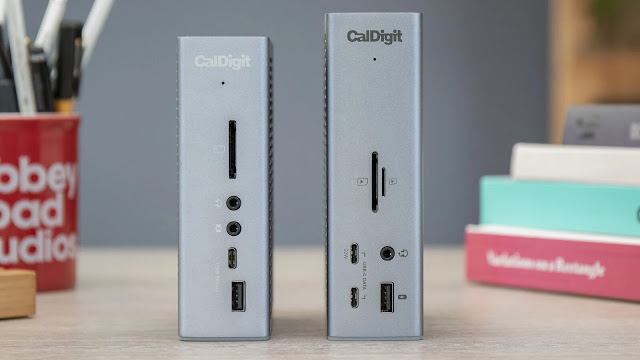 |
| Above: Caldigit TS3 Plus (left) vs Caldigit TS4 (right); front view |
Should You Upgrade From Caldigit TS3 Plus To TS4?
The TS4 is a great docking station if you are buying for the first time, but what about upgrading from an existing dock.
If your current dock has USB-C only, then upgrading to 40Gbps Thunderbolt is a must for compatible computers. As TB4 is backwards compatible, buying a future-proof Thunderbolt 4 dock makes the most sense today even if your older laptop is Thunderbolt 3 or USB-C.
The Caldigit TS3 Plus dock used to wear the docking station crown but its newer sibling the TS4 has stolen its crown. So should TS3 Plus owners upgrade, too?
Although TB4 is backwards compatible, Thunderbolt 3 MacBook or Windows users have no obvious need to upgrade as they won’t benefit from Thunderbolt 4’s smarter features. Windows TB3 owners might do better upgrading their laptop to a fully certified TB4 computer if their current TB3 PC is feature limited, as some are. Apple's TB3 MacBooks already include most (but not all) of the TB4 benefits; see above.
That said, everyone will benefit from the TS4's more numerous, faster and more powerful USB ports, and, if they have the right setup, the 2.5 Gigabit Ethernet too.
And the dock's 98W charging is a big plus for owners of larger-screen laptops; the TS3 Plus had an impressive but still lighter 87W max charging power.
Thunderbolt 4 is backwards compatible, so even if you own a USB-C or TB3 laptop or tablet now, buying a TB4 dock like the TS4 will work with your current computer and be ready for your upgrade to a Thunderbolt 4 or USB4 machine in the future.
If you prefer pro-level digital audio, the TS3 Plus's Optical Audio (S/PDIF) port didn't make the cut to the TS4.
Price
The Caldigit Thunderbolt Station 4 costs $359.95, £324.99 or €324.99.
Expectedly, this is more expensive than the TS3 Plus and also puts the TS4 at the high-end of the price range for Thunderbolt 4 docks.
If a TB4 hub – usually just four TB4 ports and one or more USB-A ports – isn’t enough for you, you need a more expensive full docking station.
There are cheaper alternatives, such as Anker Apex Thunderbolt 4 Docking Station with its two HDMI ports or the Kensington SD5700T, which is also recommended.
But none offer the range of top-end ports, power and flexible design of the TS4, which is worth the extra outlay if you can afford it.
As you’ve spent a good deal buying the best docking station, you might want to use the lock to secure the TS4 to your desk.
Verdict
While some may grumble about the built-in DisplayPort at the cost of one of the downstream TB4 ports, the Caldigit Thunderbolt Station 4 is a superbly equipped and well-designed dock.
It’s got all the top-end ports you could wish for (more than any other), a generous power supply (larger than any other) and charging strength, and a compact and flexible design (better than any other).
The TS4 replaces its Thunderbolt 3 predecessor, the TS3 Plus, as the top docking station for owners of modern laptops and tablets.



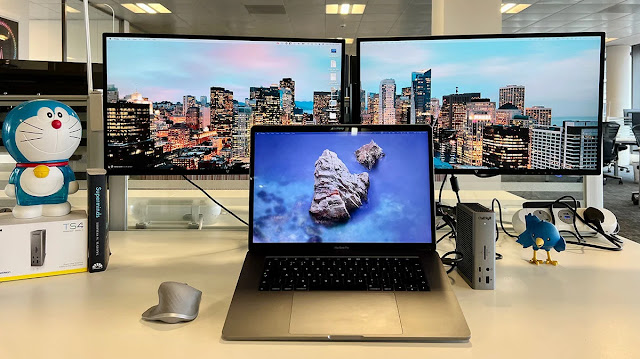
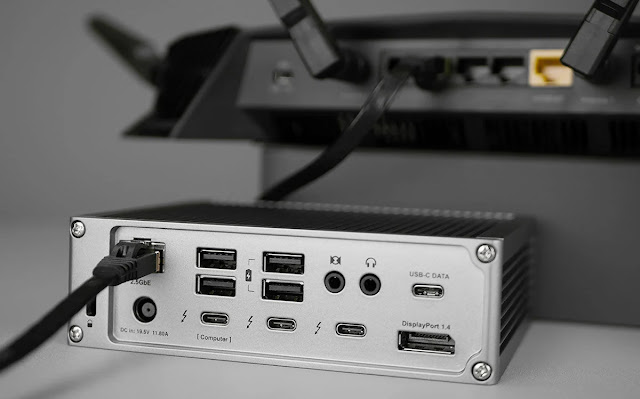
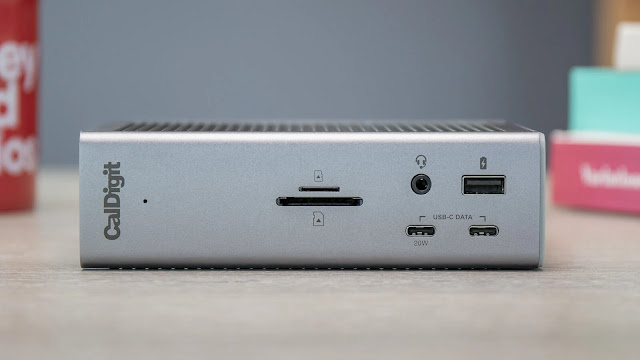
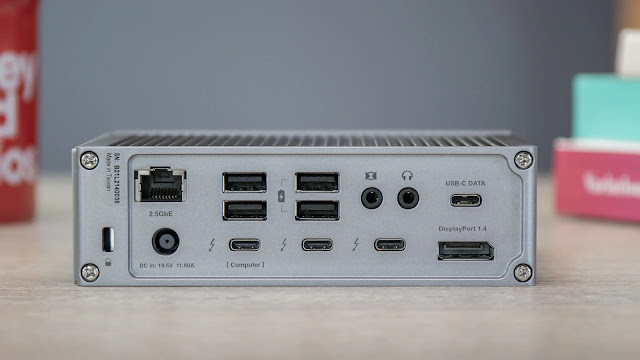


0 comments:
Post a Comment